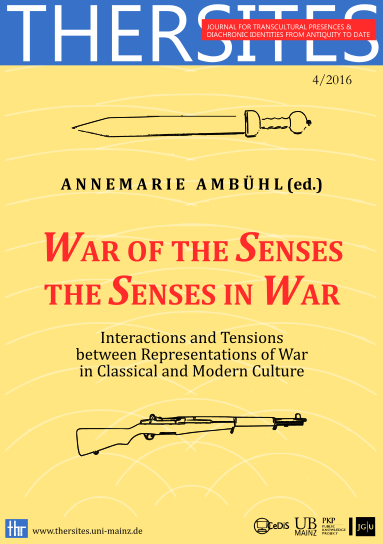Intertextuelle Emotion oder Geschlechter im Krieg: die Lemnosepisode bei Valerius Flaccus im Vergleich zu den Darstellungen des Statius und Apollonios
DOI:
https://doi.org/10.34679/thersites.vol4.39Abstract
Der Mythos von den lemnischen Frauen, die in einer durch göttliche Mächte verursachten Raserei die gesamte männliche Bevölkerung der Insel Lemnos ermorden, bietet ein interessantes Beispiel für die literarische Darstellung von Emotionen, deren Entwicklung und Konsequenzen. In dieser Erzählung eines Bürgerkrieges, der eigentlich ein Krieg zwischen den Geschlechtern ist, spielen Emotionen insbesondere in ihrer Zuordnung auf männliche und weibliche Figuren sowie auf Gruppen bzw. Individuen eine bedeutende Rolle. Die wichtigsten Darstellungen des Mythos finden sich bei Apollonios Rhodios, Valerius Flaccus und Statius; es liegen bereits Studien vor, die sich mit Unterschieden zwischen den genannten Texten befassen. Dieser Aufsatz möchte einen Beitrag zur Forschungsdiskussion liefern, indem er insbesondere die unterschiedlichen Darstellungen und Entwicklungen der Emotionen sowie deren Bedeutung für das Fortschreiten der mythischen Handlung in den Blick nimmt.
Downloads
Published
Issue
Section
License
Copyright (c) 2017 Rebekka Schirner

This work is licensed under a Creative Commons Attribution-NonCommercial 4.0 International License.
Authors who publish with thersites agree to the following terms:
- Publishing in thersites is free of any charges.
- Authors retain copyright and grant the journal right of first publication.
- Users are allowed to read, download, copy, distribute, print, search, or link to the full texts of the articles, or use them for any other lawful purpose, without asking prior permission from the publisher or the author, so long as the original work is properly cited and is not used for commercial purposes. The journal is published under the Creative Commons Attribution 4.0 International License. More information about this license is available at https://creativecommons.org/licenses/by/4.0/.
- Authors are able to enter into separate, additional contractual arrangements for the non-exclusive distribution of the journal's published version of the work (e.g., post it to an institutional repository or publish it in a book), with an acknowledgement of its initial publication in this journal.
- Authors are permitted and encouraged to post their work online (e.g., in institutional repositories or on their website) as it can lead to productive exchanges, as well as earlier and greater citation of published work (See The Effect of Open Access).


